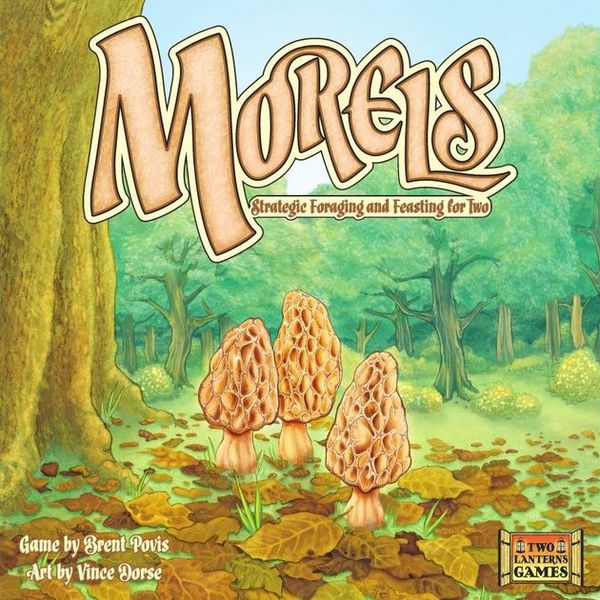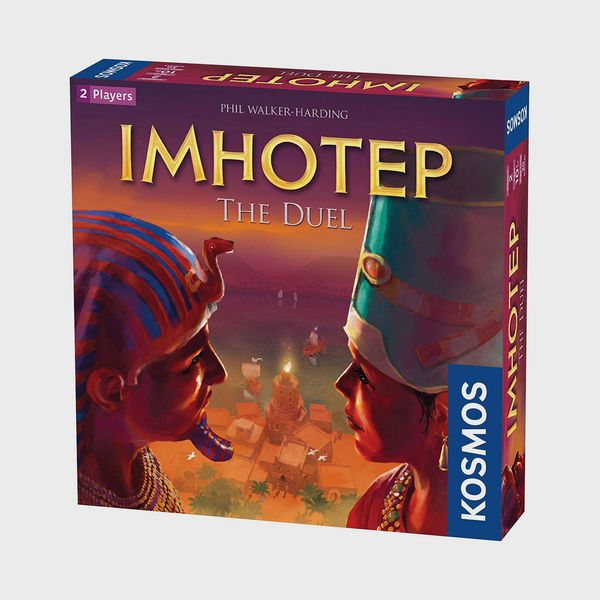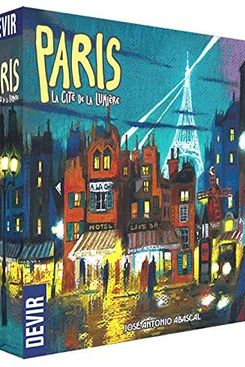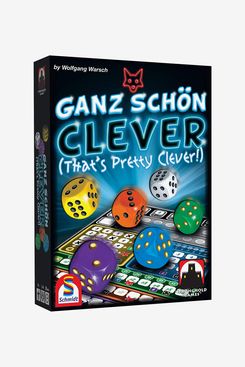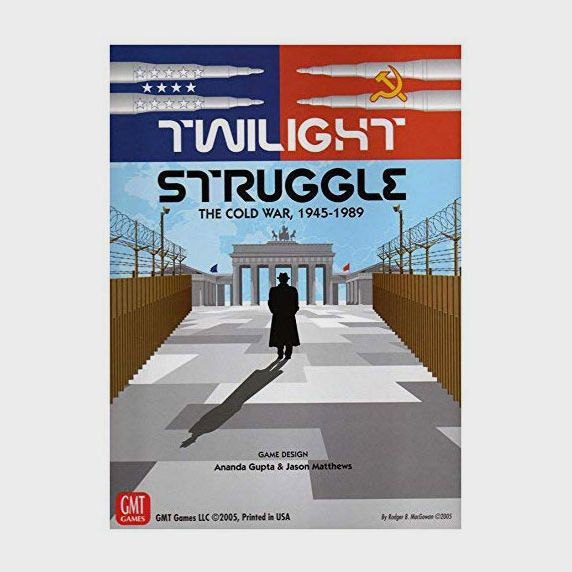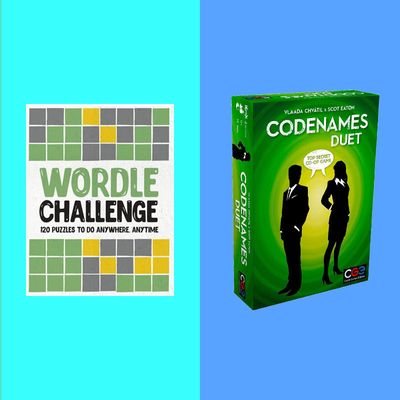
Board games are an entertaining way to pass the time — and a little more stimulating than staring at a screen. While many board games require groups of people to play, there are a lot of worthy ones that don’t. So, to find the best two-player games for couples or roommates to play together, we asked ten gaming experts about their favorites. “In the realm of two-player board games, there is something for every taste,” according to Taryn Gregory, an inventory lead at Guardian Games. Below, she and our nine other board-game experts share the two-player board games they pull out over and over again that will appeal to everyone from beginners looking for a lighthearted fantasy caper to advanced players looking for a vexing strategy game. While the majority are made for two players, there are some that can be played by more people — but our experts say those ones are often the most fun when played by just two. To make it easier for you to find the right one for you, we’ve organized the games by their level of difficulty — beginner, intermediate, and advanced — leading each category with games that got the most recommendations.
Best two-player games for beginners
Four of our experts recommended Patchwork, created by accomplished game designer Uwe Rosenberg, as one of the best two-player games for beginners. The game challenges players to strategically collect different pieces to create a quilt. Greg May, owner of The Uncommons and Hex & Company, calls it “the perfect game for couples” that is sure to delight “fans of Blokus or Tetris.” Scott Cooper, owner of Blue Highway Games, says Patchwork is his retailer’s best-selling two-person game because, although the rules are simple to understand and it only takes about 15 minutes to play, the “subtle strategy keeps it interesting.” May agrees: “Games are usually quite close, and there are just enough layers to keep you coming back without dragging things out.”
“Codenames Duet takes one of the best party games and tweaks it to make an excellent cooperative game,” says May. Three other experts also highly praised the word-deduction game as easy and fun. The rules are relatively straightforward: “Players make associations between words as they cooperate to identify targets with a limited number of guesses,” explains Cooper. And both May and Lauren Bilanko, a co-owner of Twenty Sided Store, note that there are versions of the game specifically geared toward fans of different franchises, including Harry Potter, Marvel, and Disney.
Strategist senior writer Liza Corsillo just bought the newly released board game-edition of Wordle. Designed with two players in mind, Wordle comes with 120 pages of blank grids so you can make up your own words while trying to stump your opponent, instead of relying on a randomized batch.
Strategist writer Lauren Ro, who admits she finds most board games “needlessly complicated and mind-numbingly boring,” says Bohnanza converted her from a game skeptic to a board game lover. “I didn’t think I could ever love a game, but this is the only one I actually look forward to playing and introducing to friends,” Ro says. “It’s fun. It’s fast. The artwork is delightful. Best of all, it’s easy to learn, even for a dolt like me.” The concept is simple enough: Each player is a bean farmer who plants different varieties of beans; players harvest their crops in exchange for gold, and the more beans you harvest, the more coins you collect. However, the game dictates that you play with a fixed hand, meaning you have to play it in the order the cards were dealt or drawn, which makes things a bit more complicated since your hand dictates which bean you can plant in each field at each turn. But players can barter with one another to trade beans, putting their strategy and negotiation skills to the test.
Board-game blogger Eric Yurko recommends Omega Virus: Prologue, which he describes as a “real-time card-laying space station construction game.” In it, players have identical decks of cards (some locked with keys) and need to restore three structures to fight the computer virus infecting the space station, he explains. “However, all of the cards need to be unlocked, first, and that’s done by laying cards so that the rooms on the cards form shapes depicted on Location Cards, revealed at the start of each round.” He especially likes that the game is “very small and light,” and adds that “given how fast it plays, Omega Virus: Prologue is great to play when you’ve only got 15 minutes.”
Santorini, which three folks told us about, is our experts’ second most-recommended two-player board game for beginners. Eric Yurko, an American Tabletop Awards committee member and game reviewer for his own site, What’s Eric Playing?, calls it his all-time favorite because the game “combines great art with very simple play.” Board game designer Rob Sparks is another fan, telling us you can “learn to play in just 30 seconds” and that the game “will have you building various domed towers its namesake island is famous for as you navigate the beautiful board.” Yurko also loves this building element, noting that “as players build up the board it mirrors the famous imagery of Santorini itself.” According to him, at the start of each game every player gets assigned a Greek god that grants them a different rule-breaking power, which makes “for a very quick and fun game” as the gods interact with each other. “It plays really, really well with two players,” promises board game enthusiast and Cartamundi tabletop games ambassador Sean Amdisen-Cooke, who adds that “it’s very accessible, so kids can also play.”
Strategist senior writer Liza Corsillo discovered this game by way of her “strategy-game connoisseur” brother — it quickly became a game-night staple. According to Corsillo, Raccoon Tycoon combines the fast play of Ticket to Ride with the social interaction of Settlers of Catan, “but is more engaging and fun to look at.” Like Ticket to Ride, a player will win the game by collecting the most points, “but there are multiple ways to earn them — amassing wealth and owning railroads, towns, or buildings — so it’s harder to get bored.” Corsillo also notes that part of what sets Raccoon Tycoon apart is “the intricate, uncanny illustrations,” designed by painter Annie Stegg. “Every time I play, I discover some clever detail that makes me laugh,” she adds. “Another perk is that you can play with as few as two people or as many as five, and though you have to pay attention to multiple things at once, it’s not so complicated that a beginner or child couldn’t win on their first time playing.”
If you’re looking for a “quick, snappy” game that is easy to pick up, but “still has a bit of substance to it,” Yurko suggests Cascadia, which he calls “one of my favorite casual games of 2021.” The goal of the game is to create a Pacific Northwest ecosystem by collecting animals and tiles, “but each animal scores differently depending on which of its scoring cards is in play at the start of the game.” Yurko says this allows for “a wide variety of different strategies to emerge across one or multiple games,” which keeps the gameplay dynamic. Plus, Yurko has one word to describe the work of game designer Randy Flynn: “exceptional.” He also says that it’s a game he’s shown to lots of other players who inevitably “end up just as excited about it as I am.”
Both Gregory and Bilanko recommend Hive, which Gregory describes as “a bit like chess in strategy and movement, with great pieces and no board.” The main objective is to use hexagonal tiles that are each adorned with a different bug and have unique rules to surround your opponent’s queen bee. According to Bilanko, “It’s fast to learn and easy to play, but the strategy keeps it complex, whether it’s your first time playing or your hundredth time playing.” The game’s resin tiles also make it easy to travel with: “It’s portable, so it’s great to take to the beach or on a train or to a bar, because you don’t have to worry about cards blowing away or getting spilled on,” says Bilanko.
Sparks compares Crokinole, a game that dates back to the 19th century, to kind of like playing shuffleboard, calling it a “fantastic game of skill and strategy that has stood the test of time.” Players take turns flicking discs from the outermost ring with the goal of getting them to the center of the board to score points — and knocking their opponent’s discs out of the way (making them lose points) in the process. Sparks says there is one rule that makes this a bit more challenging, though: “The discs you flick must hit an opponent’s to be kept in play,” he explains, making it even more competitive.
Yurko told us that Nova Luna is similar to Patchwork but builds on that game’s design “by adding tiles that depend on other adjacent tiles.” He calls it “colorful yet abstract,” adding that “it’s very simple to teach to new players, but strategic enough that experienced players are still having a blast with it after multiple games.”
Scandanivian game Klask bills itself as a cross between foosball and air hockey, during which players face off using a magnetic handle and striker as they try to score goals against each other. “It’s a simple addition to a tried and tested game which adds a whole depth of strategy,” notes Sparks. While a simple enough premise, Klask adds an extra level of difficulty by placing magnetic traps along the board: Get too close and one will stick to your striker, and if you get caught twice, your opponent scores and a new round begins.
According to Sparks, “Inspired by Norse mythology, Odin’s Ravens is simple to play, with delightful artwork and interesting choices that will delight anyone looking to ‘get away’ for half an hour.” According to legend, each morning, Odin releases a pair of ravens to fly around the Earth and report back to him. This lore is what inspires gameplay: “Naturally, the ravens have become quite competitive, and it is up to you and another swift soarer to circumvent the world and get back to Odin first,” says Sparks of this racing-style game.
Archaeology: The New Expedition has players adopt the role of an archaeologist excavating historical sites for relics and treasures to sell to the highest bidder. Dr. Michael James Heron of Meeple Like Us, a board-game review site with a focus on accessibility, describes it as being “quick to play, whip-sharp, and surprisingly exciting.” If you’ve played the game before, you may notice that the newer, redesigned version has higher-quality art.
In Imhotep: The Duel players try to win the game by unloading ships from a shared waterfront and earning points by collecting six different types of goods, according to Andy Matthews, the founder of board-game review site Meeple Mountain. “This game is everything I want a two-player game to be: It’s streamlined, it’s tactical, and it’s fun,” he says. Typically, playtime runs 30 minutes, and “in an average game, you might only get 15 or 20 turns.” Because there are a limited number of choices during each turn, every decision is important, he adds.
For a lightning-quick, pick-and-pass-style card game, Bilanko loves Sushi Go!, which she says is very easy to learn but still fun enough to play over and over again. The aim is to collect cards to create collections of dishes for different point values, and whoever scores the most points wins.
Matthews describes Circle the Wagons like this: “Face off against your opponent in this wallet-sized game to see who can build the best Old West boomtown.” To do so, you need to collect cards and strategically place them to build large blocks that meet the variable scoring conditions, he explains. The game is suitable for ages 8 and up, so you can even play it with kids.
Best intermediate two-player games
This two-player adaption of the popular 7 Wonders board game has “players navigate three rounds, gaining buildings to accrue resources, gold, technologies, and military might,” says Sparks. “It’s hard to understate how well this game packs a traditionally long and complicated gaming experience into just thirty minutes.” Amdisen-Cooke agrees: “What I love about this game is how well it has taken the regular 7 Wonders game and turned it into a really enjoyable two-player experience.”
“The Fox in the Forest is a fun, medium strategy game with really lovely art, making it a game to enjoy while relaxing,” according to Gregory. The card game’s general objective is to score more points than your opponent by winning more tricks. Cards feature various characters, and players use them to change the trump suit and take the lead, according to Daniel Kilbert, owner of The Compleat Strategist. It’s ideal for players who prefer a a bit of fantasy in their gaming.
According to Yurko, “Carcassonne turns 20 this year, and the classic has returned with an anniversary edition that boasts new art, some new tiles, and a new mini-expansion.” Yurko adds, “I’ve always loved it as a two-player title, as players work to build (and control) cities, roads, farms, and monasteries across a sweeping landscape.” While the gameplay is “very simple,” the complexity and fun come from its numerous expansions, making it a game you can play for years to come.
“Railroad Ink has been one of my favorite game series for a while, and Railroad Ink Challenge: Lush Green and Railroad Ink Challenge: Shining Yellow adds more to the excellent roll-and-write with new challenges, goal cards, and 20-something additional expansions that add everything from subways to aliens to weather,” explains Yurko. Like the original Railroad Ink — which was featured in both our best one-player board games and best board games for Zoom stories — players roll dice to build out a network of railroads. “Special locations on the board, when you draw a route in them, give you extra benefits, and this all combines nicely to make a game that plays well with two.” “Of the two, I slightly prefer Lush Green (it has different expansions than Shining Yellow), but I don’t think you can go wrong with either version if you’re looking for a quick and portable game,” he concludes.
Mandala is a recently released favorite of Amdisen-Cooke, who calls it “a gem.” While at first it “may seem like a simple and straightforward card game, once you play it, you realize that there’s a lot of depth and interesting strategic choices to it,” he says. Two players are tasked with collecting cards of six different colors, “but the point value for each color is only determined throughout the game — and these values will likely differ for the two players,” he explains. “There are so many nuances, and each round you’ll have to make interesting decisions to secure your preferred colors — while also making sure that your opponent doesn’t get the colors that will score them the most points.”
“In Kingdomino, players use tiles featuring different land types to build kingdoms within a set-size grid,” explains Amdisen-Cooke, who says that, while it involves some strategy, the game can also easily be played with kids. Its name — a portmanteau of kingdom and domino — nods to how you play it: Players can only add a tile to the grid if the one it abuts contains a matching land type to theirs (like how you’d match dominoes). Suitable for up to four players, he says it is one of those games that’s most fun played with just two because the rules allow for building an even bigger grid (a.k.a. kingdom) for one-on-one play. “I love this variant,” Amdisen-Cooke adds, “it’s super-fun and allows you to potentially build some really high scoring kingdoms.”
“With vibrant artwork, a chill vibe, and subtle yet serious strategy, Paris: La Cite de la Lumiere will light up your dark nights many times over,” promises Sparks. In the first half of the game, players take turns building streets in Paris “and securing various peculiarly shaped buildings,” Sparks explains. Then, in the second phase, “the objective is to place your buildings as close to the streetlights that illuminate the city” as possible, he adds. “It is a truly gorgeous two-player game with an affordable price tag.”
Amdisen-Cooke suggested That’s Pretty Clever for our Zoom-compatible board games post, but notes it’s also great for two players IRL. The main objective is to earn points by choosing from six different-colored dice for chain-scoring opportunities on your scoreboard. But you must choose wisely: Any dice you don’t pick for yourself that has a smaller value can be stolen by the other players. And if you end up loving the game, you can kick things up a notch with Twice as Clever, which has the same concept but “is slightly more complex.”
For fans of Jurassic Park, Sparks suggests Raptor, where players either take “command over a cohort of field scientists, capturing baby raptors and bringing down the mama raptor by any means necessary, or wreak havoc as the raptors themselves, controlling a boss-like dinosaur that will gobble up scientists.” If the scientists capture three out of the five baby raptors, they win. If the raptors eat all of the scientists or help three baby raptors escape, they win.
“KERO is an action-packed two-player game set in a postapocalyptic wasteland à la Mad Max, where players assume the roles of two clans that are trying to survive,” explains Amdisen-Cooke. “The game is played over three rounds, where each clan tries to secure the best territories (and as many territories as possible), while desperately attempting to not run out of kerosene.” He notes that the most fun part of the game is the frantic dice rolling element, because players have to try to roll the best numbers before the sand in the timer runs out. “Your final dice rolls then determine which resources you have available that round, and how you can spend them.” While this may sound like a difficult game, Amdisen-Cooke says it’s simple enough to be played with older kids.
According to Amdisen-Cooke, “Agricola is an absolute classic in the board-game community, and this version is specifically designed for two players based on its parent game.” While the game, at only 30 minutes, is “fast and fun,” he promises you still “get such a huge game experience with a lot of depth and choices.” Players roleplay as farmers seeking to make the most out of their land. While that sounds simple enough, “you’ll need to prioritize and make clever strategic choices, especially as there are multiple paths to victory,” he says. Amdisen-Cooke adds that the design and quality of the game are top-notch: It has “stunning components and beautiful animal-shaped wooden meeples,” he says. Heads up: Only a few are left in stock!
The Quacks of Quedlinburg is one of Amdisen-Cooke’s “all-time favorite games” to play with two players. “It’s a push-your-luck-style game where players draw blindly from their ingredient bags,” he says. Some ingredients will help you gain points and coins which you then spend on more resources. “But if you draw too many of the wrong ingredients, your pot will explode and you’ll have to make the hard choice between getting only victory points or coins,” which will put you behind your opponent, he explains. It combines both strategy and luck to create “a really enjoyable experience,” he promises.
Bilanko describes Tiny Towns as a “resource management game,” in which players attempt to construct their own towns using the cards and pieces available on the board. Tiny Towns is designed for two to six players, so couples or roommates can play by themselves or whip it out when hosting a larger game night. “It’s really versatile and it scales really well,” Bilanko says.
Bilanko also loves Haven, because it “really immerses you in the story.” The intense battle-strategy game pits players one on one, challenging them to either attack or protect woodland creatures that live in a fantastical forest. “The artwork is phenomenal and it has a good level of complexity,” she says.
Caper combines elements of a drafting card game (players start with a handful of cards and then take more to build a stronger hand) with a whodunit-style murder mystery along the lines of Clue. But unlike Clue, which is best played with a group, this is perfect for a pair, says Bilanko. “Usually you see mechanics like this in games where you have to have three or more players, because of the intrigue level.” The game allows players to hire and equip a crew of thieves, who then attempt to plunder famous sites across Europe. It’s wacky, colorful, and fun, according to Bilanko, who adds, “The artwork is amazing to look at.”
Star Realms is a “medium-weight strategy game that plays quickly,” says Gregory, so it’s suitable for players who like a challenge but don’t want to spend their whole afternoon on the same game. The game combines elements of deck-building as you seek to build up your military, as well as the interactive component of trading-card-style combat as you face off to attack your opponent.
If you’re longing for the outdoors but stuck inside, Heron says to try the “clever and beautiful” Parks, which he describes as “a wonderful, evocative hike through the National Park System of America.” The game features 48 unique illustrations from over 35 artists, as well as 102 color-coded wood tokens that feature 12 delicately carved animals native to the country’s parks. And don’t worry about losing the pieces: The game contains one box organizer and two removable resource trays to keep things organized. Players take on the role of two hikers as they navigate different trails, collecting memories of the different places they visit. The game is played in four rounds, each one representing a different season, with the trail tiles being shuffled and rearranged before players begin the next round.
For a more tactile game, Matthews suggests Shōbu, an abstract strategy game where players take turns maneuvering their stones on four different boards, hoping to push their opponent’s pieces off. “If all four of a player’s stones are lost on any single board, the game ends in victory for their opponent,” he explains. It’s similar to chess, Matthews says, but better designed with wooden boards and river stones that give the game “an air of thoughtfulness.”
Best advanced two-player games
According to Amdisen-Cooke, “The Castles of Burgundy is a classic that works well for just two,” even though it’s suitable for up to four players. The main objective is for players to create expansive estates, and while he says that its five rounds make gameplay “definitely on the more involved end,” Amdisen-Cooke promises this is “a game that is extensively praised in the board-game community.”
Sparks tells us that this game invites you to “play as the fabled Robinson Crusoe as he and his crew become shipwrecked on a cursed island and must explore, hunt, shelter, and hopefully escape the island before it’s too late.” He adds that the game is considered “one of the all-time greatest survival board games,” making it a particularly relevant one to consider these days. While he notes there a lot of rules that make it complex, Sparks says it’s well worth the effort to learn. “What you’ll find is a dynamic and tense game that will have you cheering at every lucky card draw and dreading everything else. It’s utterly brilliant.”
Arkham Horror is “a rich storytelling experience filled with unique encounters, secrets to uncover, and a campaign that unfolds whether you win or lose,” according to Sparks, who calls it “a great game to get lost in with a buddy.” It blends together a traditional card game with role-playing elements as players take on the roles of two investigators — each with their own particular strengths and weaknesses — who attempt to solve mysteries. “This experience of mystery and horror is totally worth your attention,” he promises. And after you’ve played it again and again, “there is a smorgasbord of expansions you can get to breathe further life into this living card game.”
Rivals for Catan has “a lot of the elements that makes the classic Catan such a great game” but is specifically designed for just two players, explains Amdisen-Cooke, who calls it “a must-play for Catan fans.”
According to May, Twilight Struggle is “widely considered one of the best two-player games — and one of the best games of all time.” The historical game takes about three hours to play, and simulates the tension between the Soviet Union and the United States during the Cold War. Gregory calls it a “perennial favorite among hardcore gamers” that is “very strategy heavy.” It can seem a bit overwhelming at first, but she says it’s worth the investment because “every card is unique and interesting” and the game play has a “fine-tuned balance and variety of options.” (Gregory especially recommends it for anyone who likes to play Risk.)
Sherlock Holmes: Consulting Detective is a “challenging, absorbing, and quietly immersive” game that asks players to sift through a box of old newspapers, narrative vignettes, and clues to solve a mystery that “puts you and your partner right at the center of the story,” says Heron. It’s best for those with some time on their hands or those who like a challenge, because “it’s a slow-paced, cerebral affair of poring over evidence and making deductive leaps.” The box contains ten different mysteries and can even be played solo if your roommate decides to tap out.
For an abstract strategy game that’s a little more challenging than Shōbu, Matthews loves Push Fight, which he says “hums like a perfectly tuned engine.” Each player has five pieces: Three large, square pushers and two small, rounded pawns, which you must navigate around a 26-space board. “The object is simple: Push just one of your opponent’s pieces from the board,” he says. But the tension of the game lies in the small size of the board. “Every move carries huge importance, and one misstep can spell instant doom,” according to Matthews.
For true board-game aficionados (or Lord of the Rings fans), Sparks suggests War of the Ring, which he calls “a frankly ridiculous two-player game of Middle-earth fantasy that will melt your brain the first time you play it but still somehow leave you longing for more.” He warns that the average playtime rivals how long it takes to watch the trilogy of films itself. “It’s really not for the faint of heart, but if you can penetrate War of the Ring’s thick, armor-clad rule book, and find a buddy brave enough to join you, what you’ll find is one of the richest, true-to-text experiences any Tolkien fan could ask for.”
The Strategist is designed to surface the most useful, expert recommendations for things to buy across the vast e-commerce landscape. Some of our latest conquests include the best acne treatments, rolling luggage, pillows for side sleepers, natural anxiety remedies, and bath towels. We update links when possible, but note that deals can expire and all prices are subject to change.















